Report on Logistics & Supply Chain Management Issues at BIS Industries
VerifiedAdded on 2023/04/23
|10
|3691
|322
Report
AI Summary
This report examines the logistics and supply chain management challenges faced by BIS Industries, a major Australian logistics company. It identifies key issues in New South Wales (NSW), including traffic congestion, road conditions, environmental concerns, and coordination problems. The report discusses the impact of these challenges on delivery times and customer satisfaction. It also explores potential solutions, such as developing an intermodal transport system, improving road infrastructure, and utilizing community conveyance. The analysis emphasizes the importance of integrating rail and airport facilities to enhance logistics operations and address environmental problems. The report concludes by suggesting measures like appointing planning authorities to examine route maps and traffic flow to mitigate transportation challenges and improve overall supply chain efficiency for BIS Industries in NSW.
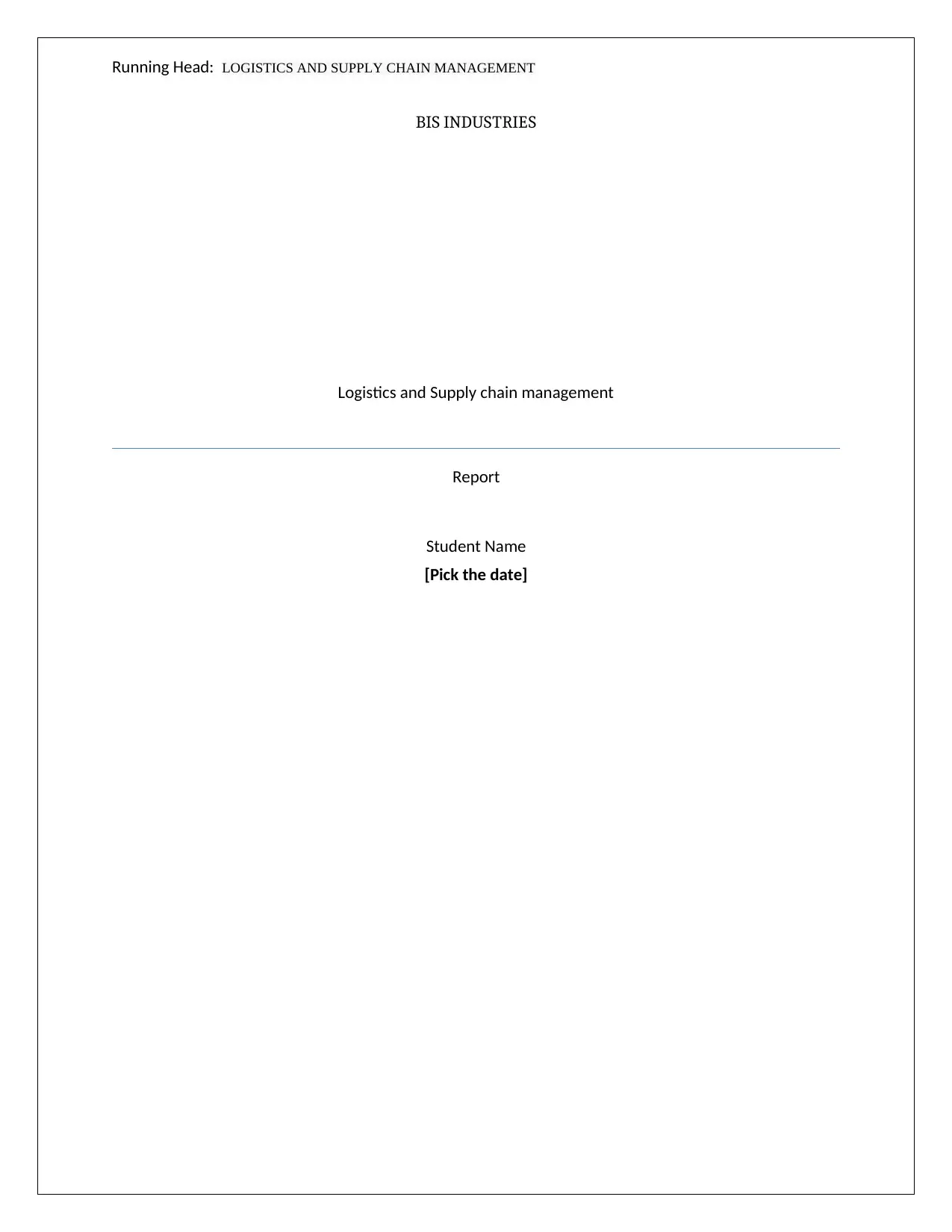
Running Head: LOGISTICS AND SUPPLY CHAIN MANAGEMENT
BIS INDUSTRIES
Logistics and Supply chain management
Report
Student Name
[Pick the date]
BIS INDUSTRIES
Logistics and Supply chain management
Report
Student Name
[Pick the date]
Paraphrase This Document
Need a fresh take? Get an instant paraphrase of this document with our AI Paraphraser
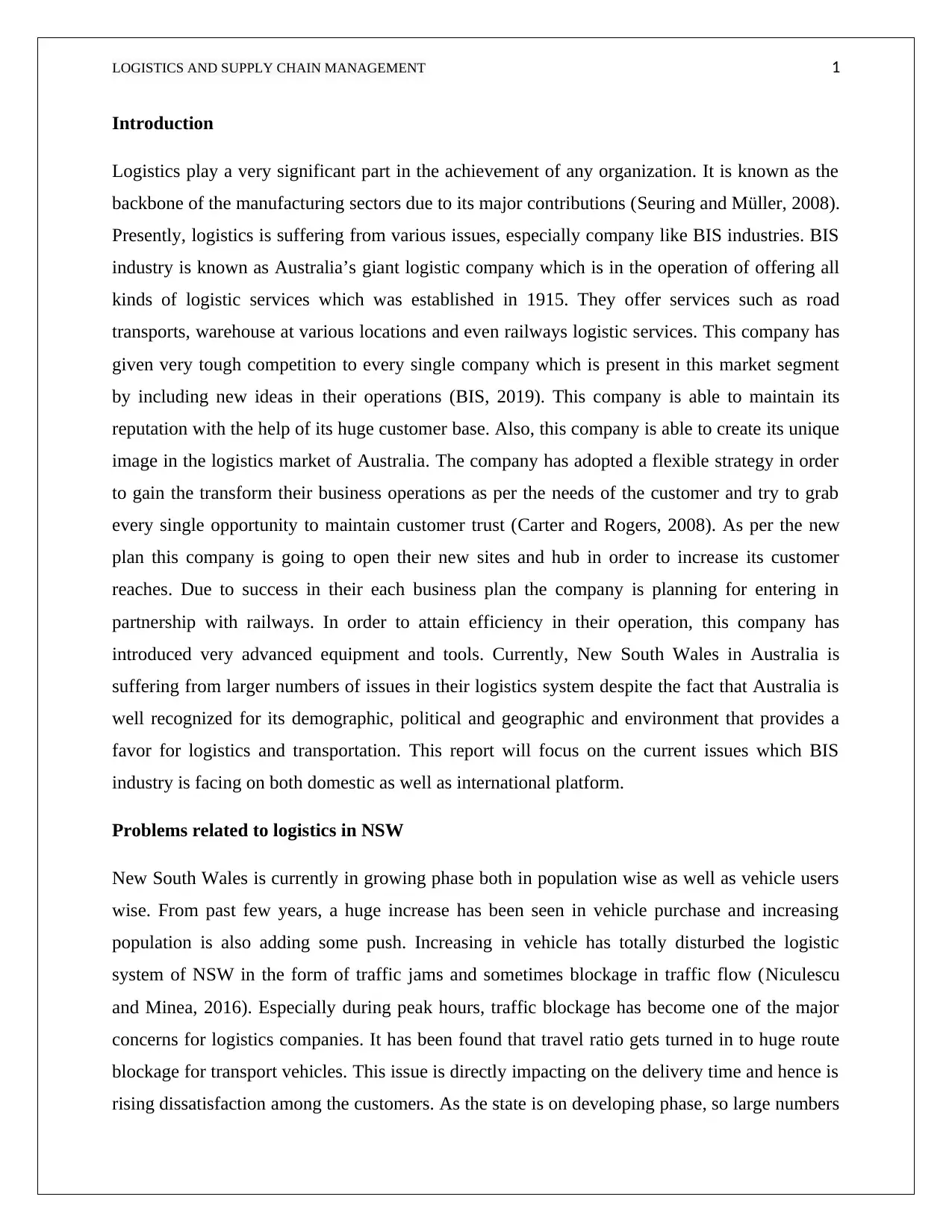
LOGISTICS AND SUPPLY CHAIN MANAGEMENT 1
Introduction
Logistics play a very significant part in the achievement of any organization. It is known as the
backbone of the manufacturing sectors due to its major contributions (Seuring and Müller, 2008).
Presently, logistics is suffering from various issues, especially company like BIS industries. BIS
industry is known as Australia’s giant logistic company which is in the operation of offering all
kinds of logistic services which was established in 1915. They offer services such as road
transports, warehouse at various locations and even railways logistic services. This company has
given very tough competition to every single company which is present in this market segment
by including new ideas in their operations (BIS, 2019). This company is able to maintain its
reputation with the help of its huge customer base. Also, this company is able to create its unique
image in the logistics market of Australia. The company has adopted a flexible strategy in order
to gain the transform their business operations as per the needs of the customer and try to grab
every single opportunity to maintain customer trust (Carter and Rogers, 2008). As per the new
plan this company is going to open their new sites and hub in order to increase its customer
reaches. Due to success in their each business plan the company is planning for entering in
partnership with railways. In order to attain efficiency in their operation, this company has
introduced very advanced equipment and tools. Currently, New South Wales in Australia is
suffering from larger numbers of issues in their logistics system despite the fact that Australia is
well recognized for its demographic, political and geographic and environment that provides a
favor for logistics and transportation. This report will focus on the current issues which BIS
industry is facing on both domestic as well as international platform.
Problems related to logistics in NSW
New South Wales is currently in growing phase both in population wise as well as vehicle users
wise. From past few years, a huge increase has been seen in vehicle purchase and increasing
population is also adding some push. Increasing in vehicle has totally disturbed the logistic
system of NSW in the form of traffic jams and sometimes blockage in traffic flow (Niculescu
and Minea, 2016). Especially during peak hours, traffic blockage has become one of the major
concerns for logistics companies. It has been found that travel ratio gets turned in to huge route
blockage for transport vehicles. This issue is directly impacting on the delivery time and hence is
rising dissatisfaction among the customers. As the state is on developing phase, so large numbers
Introduction
Logistics play a very significant part in the achievement of any organization. It is known as the
backbone of the manufacturing sectors due to its major contributions (Seuring and Müller, 2008).
Presently, logistics is suffering from various issues, especially company like BIS industries. BIS
industry is known as Australia’s giant logistic company which is in the operation of offering all
kinds of logistic services which was established in 1915. They offer services such as road
transports, warehouse at various locations and even railways logistic services. This company has
given very tough competition to every single company which is present in this market segment
by including new ideas in their operations (BIS, 2019). This company is able to maintain its
reputation with the help of its huge customer base. Also, this company is able to create its unique
image in the logistics market of Australia. The company has adopted a flexible strategy in order
to gain the transform their business operations as per the needs of the customer and try to grab
every single opportunity to maintain customer trust (Carter and Rogers, 2008). As per the new
plan this company is going to open their new sites and hub in order to increase its customer
reaches. Due to success in their each business plan the company is planning for entering in
partnership with railways. In order to attain efficiency in their operation, this company has
introduced very advanced equipment and tools. Currently, New South Wales in Australia is
suffering from larger numbers of issues in their logistics system despite the fact that Australia is
well recognized for its demographic, political and geographic and environment that provides a
favor for logistics and transportation. This report will focus on the current issues which BIS
industry is facing on both domestic as well as international platform.
Problems related to logistics in NSW
New South Wales is currently in growing phase both in population wise as well as vehicle users
wise. From past few years, a huge increase has been seen in vehicle purchase and increasing
population is also adding some push. Increasing in vehicle has totally disturbed the logistic
system of NSW in the form of traffic jams and sometimes blockage in traffic flow (Niculescu
and Minea, 2016). Especially during peak hours, traffic blockage has become one of the major
concerns for logistics companies. It has been found that travel ratio gets turned in to huge route
blockage for transport vehicles. This issue is directly impacting on the delivery time and hence is
rising dissatisfaction among the customers. As the state is on developing phase, so large numbers
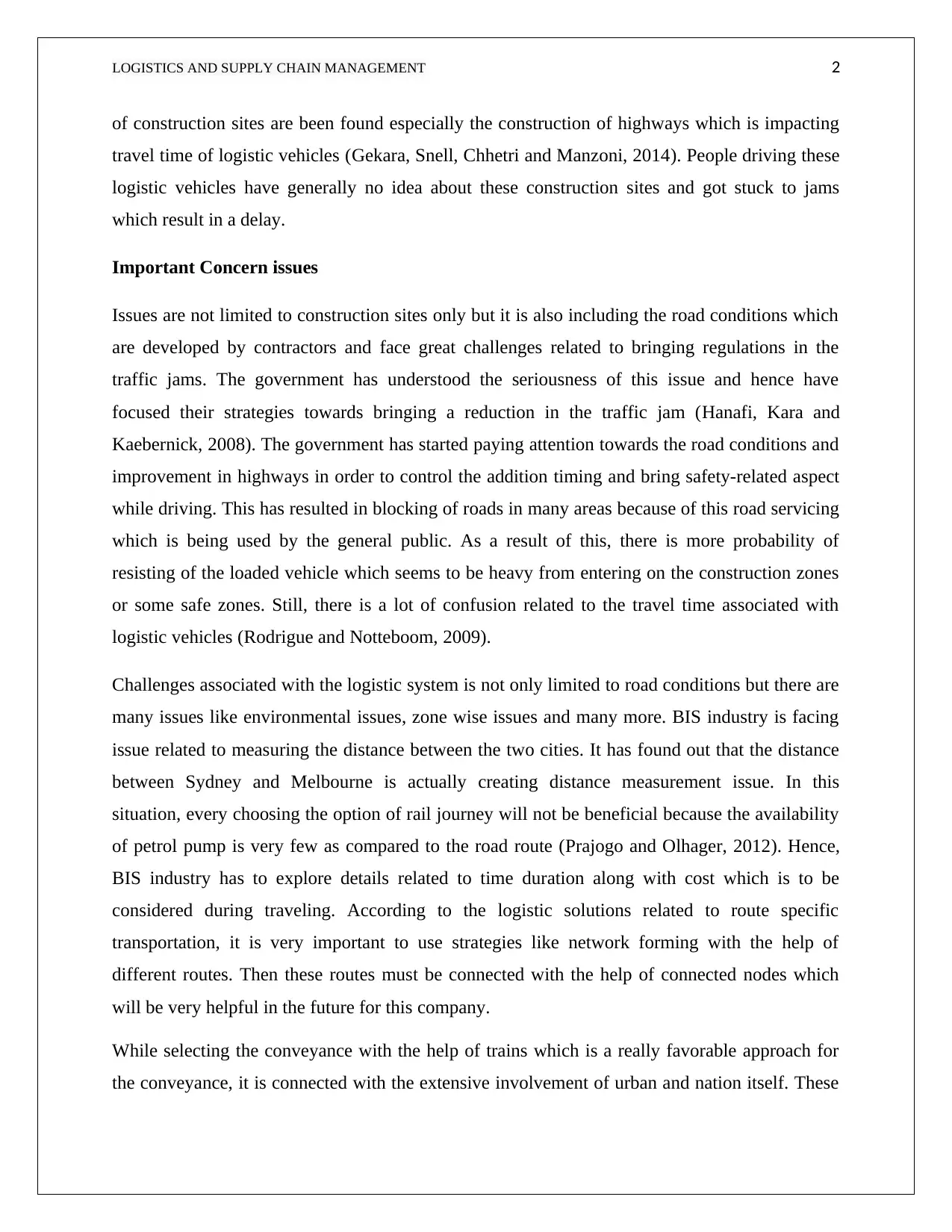
LOGISTICS AND SUPPLY CHAIN MANAGEMENT 2
of construction sites are been found especially the construction of highways which is impacting
travel time of logistic vehicles (Gekara, Snell, Chhetri and Manzoni, 2014). People driving these
logistic vehicles have generally no idea about these construction sites and got stuck to jams
which result in a delay.
Important Concern issues
Issues are not limited to construction sites only but it is also including the road conditions which
are developed by contractors and face great challenges related to bringing regulations in the
traffic jams. The government has understood the seriousness of this issue and hence have
focused their strategies towards bringing a reduction in the traffic jam (Hanafi, Kara and
Kaebernick, 2008). The government has started paying attention towards the road conditions and
improvement in highways in order to control the addition timing and bring safety-related aspect
while driving. This has resulted in blocking of roads in many areas because of this road servicing
which is being used by the general public. As a result of this, there is more probability of
resisting of the loaded vehicle which seems to be heavy from entering on the construction zones
or some safe zones. Still, there is a lot of confusion related to the travel time associated with
logistic vehicles (Rodrigue and Notteboom, 2009).
Challenges associated with the logistic system is not only limited to road conditions but there are
many issues like environmental issues, zone wise issues and many more. BIS industry is facing
issue related to measuring the distance between the two cities. It has found out that the distance
between Sydney and Melbourne is actually creating distance measurement issue. In this
situation, every choosing the option of rail journey will not be beneficial because the availability
of petrol pump is very few as compared to the road route (Prajogo and Olhager, 2012). Hence,
BIS industry has to explore details related to time duration along with cost which is to be
considered during traveling. According to the logistic solutions related to route specific
transportation, it is very important to use strategies like network forming with the help of
different routes. Then these routes must be connected with the help of connected nodes which
will be very helpful in the future for this company.
While selecting the conveyance with the help of trains which is a really favorable approach for
the conveyance, it is connected with the extensive involvement of urban and nation itself. These
of construction sites are been found especially the construction of highways which is impacting
travel time of logistic vehicles (Gekara, Snell, Chhetri and Manzoni, 2014). People driving these
logistic vehicles have generally no idea about these construction sites and got stuck to jams
which result in a delay.
Important Concern issues
Issues are not limited to construction sites only but it is also including the road conditions which
are developed by contractors and face great challenges related to bringing regulations in the
traffic jams. The government has understood the seriousness of this issue and hence have
focused their strategies towards bringing a reduction in the traffic jam (Hanafi, Kara and
Kaebernick, 2008). The government has started paying attention towards the road conditions and
improvement in highways in order to control the addition timing and bring safety-related aspect
while driving. This has resulted in blocking of roads in many areas because of this road servicing
which is being used by the general public. As a result of this, there is more probability of
resisting of the loaded vehicle which seems to be heavy from entering on the construction zones
or some safe zones. Still, there is a lot of confusion related to the travel time associated with
logistic vehicles (Rodrigue and Notteboom, 2009).
Challenges associated with the logistic system is not only limited to road conditions but there are
many issues like environmental issues, zone wise issues and many more. BIS industry is facing
issue related to measuring the distance between the two cities. It has found out that the distance
between Sydney and Melbourne is actually creating distance measurement issue. In this
situation, every choosing the option of rail journey will not be beneficial because the availability
of petrol pump is very few as compared to the road route (Prajogo and Olhager, 2012). Hence,
BIS industry has to explore details related to time duration along with cost which is to be
considered during traveling. According to the logistic solutions related to route specific
transportation, it is very important to use strategies like network forming with the help of
different routes. Then these routes must be connected with the help of connected nodes which
will be very helpful in the future for this company.
While selecting the conveyance with the help of trains which is a really favorable approach for
the conveyance, it is connected with the extensive involvement of urban and nation itself. These
⊘ This is a preview!⊘
Do you want full access?
Subscribe today to unlock all pages.

Trusted by 1+ million students worldwide
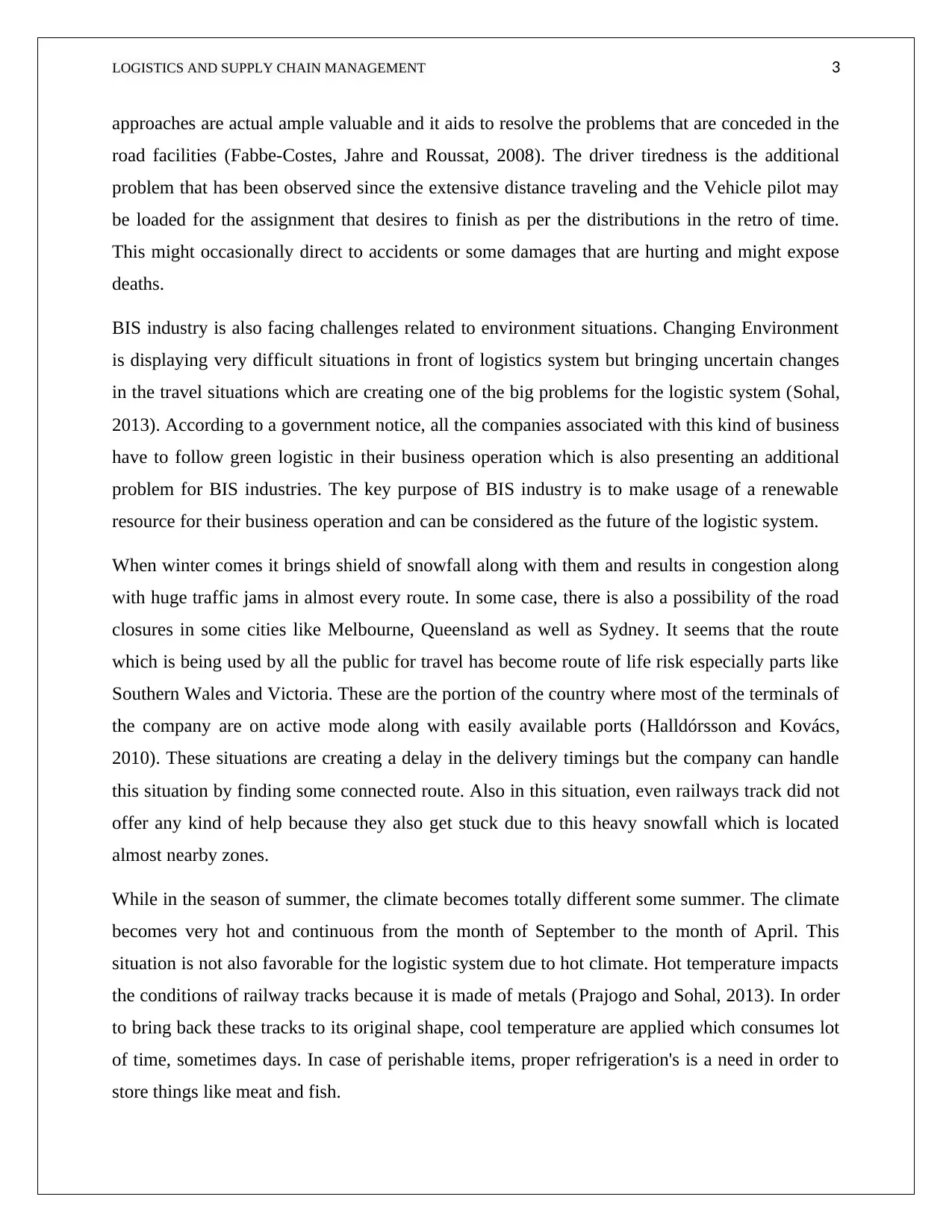
LOGISTICS AND SUPPLY CHAIN MANAGEMENT 3
approaches are actual ample valuable and it aids to resolve the problems that are conceded in the
road facilities (Fabbe-Costes, Jahre and Roussat, 2008). The driver tiredness is the additional
problem that has been observed since the extensive distance traveling and the Vehicle pilot may
be loaded for the assignment that desires to finish as per the distributions in the retro of time.
This might occasionally direct to accidents or some damages that are hurting and might expose
deaths.
BIS industry is also facing challenges related to environment situations. Changing Environment
is displaying very difficult situations in front of logistics system but bringing uncertain changes
in the travel situations which are creating one of the big problems for the logistic system (Sohal,
2013). According to a government notice, all the companies associated with this kind of business
have to follow green logistic in their business operation which is also presenting an additional
problem for BIS industries. The key purpose of BIS industry is to make usage of a renewable
resource for their business operation and can be considered as the future of the logistic system.
When winter comes it brings shield of snowfall along with them and results in congestion along
with huge traffic jams in almost every route. In some case, there is also a possibility of the road
closures in some cities like Melbourne, Queensland as well as Sydney. It seems that the route
which is being used by all the public for travel has become route of life risk especially parts like
Southern Wales and Victoria. These are the portion of the country where most of the terminals of
the company are on active mode along with easily available ports (Halldórsson and Kovács,
2010). These situations are creating a delay in the delivery timings but the company can handle
this situation by finding some connected route. Also in this situation, even railways track did not
offer any kind of help because they also get stuck due to this heavy snowfall which is located
almost nearby zones.
While in the season of summer, the climate becomes totally different some summer. The climate
becomes very hot and continuous from the month of September to the month of April. This
situation is not also favorable for the logistic system due to hot climate. Hot temperature impacts
the conditions of railway tracks because it is made of metals (Prajogo and Sohal, 2013). In order
to bring back these tracks to its original shape, cool temperature are applied which consumes lot
of time, sometimes days. In case of perishable items, proper refrigeration's is a need in order to
store things like meat and fish.
approaches are actual ample valuable and it aids to resolve the problems that are conceded in the
road facilities (Fabbe-Costes, Jahre and Roussat, 2008). The driver tiredness is the additional
problem that has been observed since the extensive distance traveling and the Vehicle pilot may
be loaded for the assignment that desires to finish as per the distributions in the retro of time.
This might occasionally direct to accidents or some damages that are hurting and might expose
deaths.
BIS industry is also facing challenges related to environment situations. Changing Environment
is displaying very difficult situations in front of logistics system but bringing uncertain changes
in the travel situations which are creating one of the big problems for the logistic system (Sohal,
2013). According to a government notice, all the companies associated with this kind of business
have to follow green logistic in their business operation which is also presenting an additional
problem for BIS industries. The key purpose of BIS industry is to make usage of a renewable
resource for their business operation and can be considered as the future of the logistic system.
When winter comes it brings shield of snowfall along with them and results in congestion along
with huge traffic jams in almost every route. In some case, there is also a possibility of the road
closures in some cities like Melbourne, Queensland as well as Sydney. It seems that the route
which is being used by all the public for travel has become route of life risk especially parts like
Southern Wales and Victoria. These are the portion of the country where most of the terminals of
the company are on active mode along with easily available ports (Halldórsson and Kovács,
2010). These situations are creating a delay in the delivery timings but the company can handle
this situation by finding some connected route. Also in this situation, even railways track did not
offer any kind of help because they also get stuck due to this heavy snowfall which is located
almost nearby zones.
While in the season of summer, the climate becomes totally different some summer. The climate
becomes very hot and continuous from the month of September to the month of April. This
situation is not also favorable for the logistic system due to hot climate. Hot temperature impacts
the conditions of railway tracks because it is made of metals (Prajogo and Sohal, 2013). In order
to bring back these tracks to its original shape, cool temperature are applied which consumes lot
of time, sometimes days. In case of perishable items, proper refrigeration's is a need in order to
store things like meat and fish.
Paraphrase This Document
Need a fresh take? Get an instant paraphrase of this document with our AI Paraphraser

LOGISTICS AND SUPPLY CHAIN MANAGEMENT 4
Another issue related to the logistic system is coordination problems, facilities, and expansion of
intermodal crossing point. There are few modes which offer sufficient connections, transport
associations which permit the towns to link with one other (Juan Ding, Jie, Parton, and Matanda,
2014). However NWS has enormous docks and corporations like BIS industries facilitating the
logistics industry, offering large scales logistic services like railway and air transport is not
possible for small logistic companies. Furthermore, NSW is facing problems of dry mud,
overcrowding in the roads, road traffic jams, and huge carbon release. By the upsurge in import
and export wants of NWS, it is actual significant to advance the logistics facilities and to offer
extra logistics and deportment facilities for quicker and better-quality facilities.
The preceding conveyance modes like the Unimodal has remained implemented in which the rail
and road grounded projects were established in a dissimilar pattern deprived of more exploration
and deliberation concerning its future expansion (Bhatnagar and Teo, 2009). Though, the
multimode or intermodal utilize extra than one way of transport in order to transfer merchandises
to the endpoint. The intermodal comprise transport bulges, relations and the operative facilities
and the expansion of the rail, road and sea docks is highlighted.
Possible solutions to these issues
The finest resolution for NSW to advance its supply chain logistics problems is to grow and
apply an intermodal for the logistic system. For conveyance intermodal comprises an additional
pattern of transport which can be utilized for transporting the merchandises. This will help in
opening ways related to coastlines, air transport, and the road transport services for NSW. This
pattern of transportation will offer operative and better-quality services (Brandenburg, Govindan,
Sarkis and Seuring, 2014). The docks will get advanced in terms of both global and
countrywide, transport will get faster and the import and export structures might get improved.
Each conceivable mode or style of transport such as docks, airports, streams, oceans, and island
docks will be uncovered for transportation and logistics system. Corporations like BIS industry
are preparing to discover these choices and initiate their logistics system with the help of rail and
airport facilities. This will surely offer more logistics openings to NSW. This will also help in
linking transport with the highways, waterways, and railways by improving hindering which are
associated with the transportation system of NSW. While focusing the environmental problems,
these transportation connections can be unwrapped for logistics facilities. A master proposal can
Another issue related to the logistic system is coordination problems, facilities, and expansion of
intermodal crossing point. There are few modes which offer sufficient connections, transport
associations which permit the towns to link with one other (Juan Ding, Jie, Parton, and Matanda,
2014). However NWS has enormous docks and corporations like BIS industries facilitating the
logistics industry, offering large scales logistic services like railway and air transport is not
possible for small logistic companies. Furthermore, NSW is facing problems of dry mud,
overcrowding in the roads, road traffic jams, and huge carbon release. By the upsurge in import
and export wants of NWS, it is actual significant to advance the logistics facilities and to offer
extra logistics and deportment facilities for quicker and better-quality facilities.
The preceding conveyance modes like the Unimodal has remained implemented in which the rail
and road grounded projects were established in a dissimilar pattern deprived of more exploration
and deliberation concerning its future expansion (Bhatnagar and Teo, 2009). Though, the
multimode or intermodal utilize extra than one way of transport in order to transfer merchandises
to the endpoint. The intermodal comprise transport bulges, relations and the operative facilities
and the expansion of the rail, road and sea docks is highlighted.
Possible solutions to these issues
The finest resolution for NSW to advance its supply chain logistics problems is to grow and
apply an intermodal for the logistic system. For conveyance intermodal comprises an additional
pattern of transport which can be utilized for transporting the merchandises. This will help in
opening ways related to coastlines, air transport, and the road transport services for NSW. This
pattern of transportation will offer operative and better-quality services (Brandenburg, Govindan,
Sarkis and Seuring, 2014). The docks will get advanced in terms of both global and
countrywide, transport will get faster and the import and export structures might get improved.
Each conceivable mode or style of transport such as docks, airports, streams, oceans, and island
docks will be uncovered for transportation and logistics system. Corporations like BIS industry
are preparing to discover these choices and initiate their logistics system with the help of rail and
airport facilities. This will surely offer more logistics openings to NSW. This will also help in
linking transport with the highways, waterways, and railways by improving hindering which are
associated with the transportation system of NSW. While focusing the environmental problems,
these transportation connections can be unwrapped for logistics facilities. A master proposal can
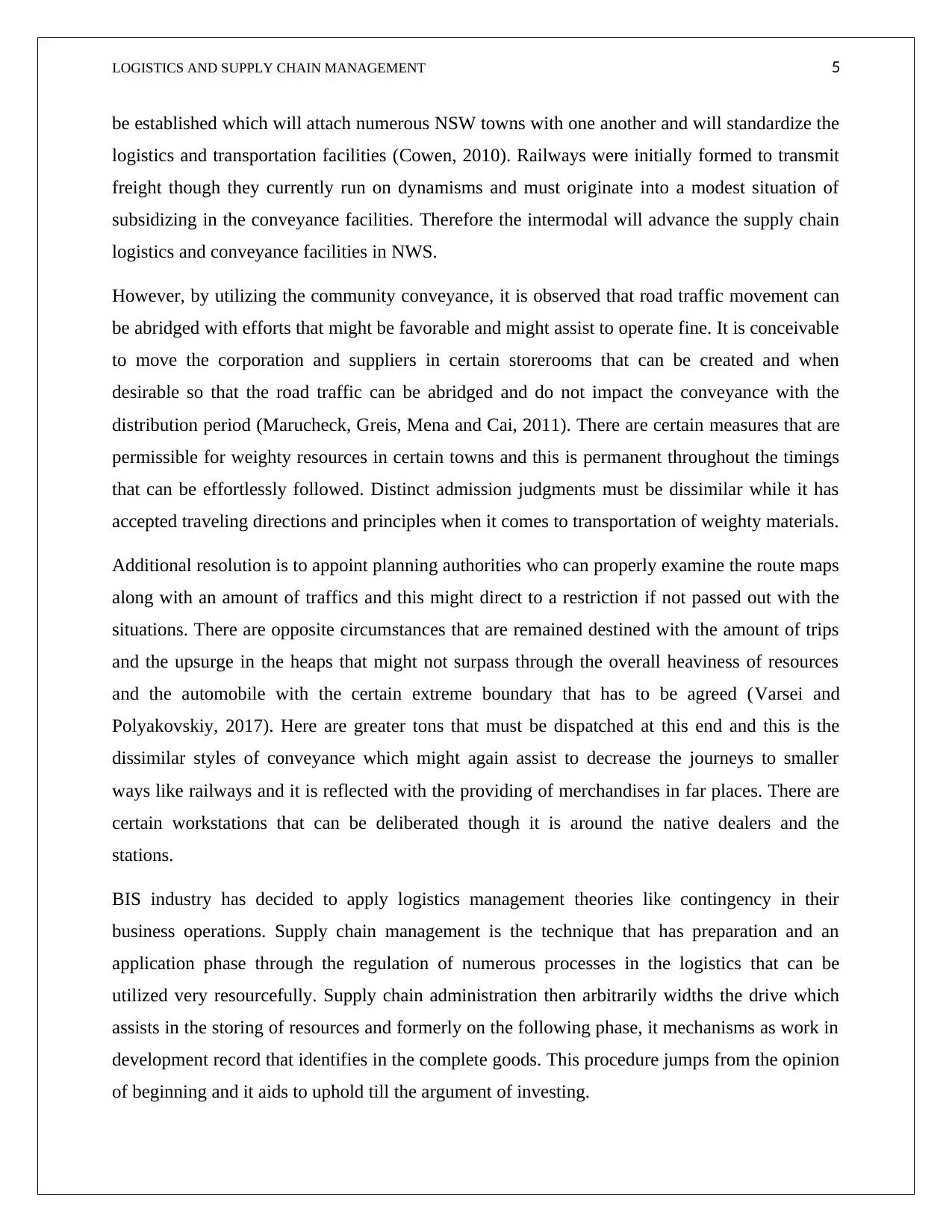
LOGISTICS AND SUPPLY CHAIN MANAGEMENT 5
be established which will attach numerous NSW towns with one another and will standardize the
logistics and transportation facilities (Cowen, 2010). Railways were initially formed to transmit
freight though they currently run on dynamisms and must originate into a modest situation of
subsidizing in the conveyance facilities. Therefore the intermodal will advance the supply chain
logistics and conveyance facilities in NWS.
However, by utilizing the community conveyance, it is observed that road traffic movement can
be abridged with efforts that might be favorable and might assist to operate fine. It is conceivable
to move the corporation and suppliers in certain storerooms that can be created and when
desirable so that the road traffic can be abridged and do not impact the conveyance with the
distribution period (Marucheck, Greis, Mena and Cai, 2011). There are certain measures that are
permissible for weighty resources in certain towns and this is permanent throughout the timings
that can be effortlessly followed. Distinct admission judgments must be dissimilar while it has
accepted traveling directions and principles when it comes to transportation of weighty materials.
Additional resolution is to appoint planning authorities who can properly examine the route maps
along with an amount of traffics and this might direct to a restriction if not passed out with the
situations. There are opposite circumstances that are remained destined with the amount of trips
and the upsurge in the heaps that might not surpass through the overall heaviness of resources
and the automobile with the certain extreme boundary that has to be agreed (Varsei and
Polyakovskiy, 2017). Here are greater tons that must be dispatched at this end and this is the
dissimilar styles of conveyance which might again assist to decrease the journeys to smaller
ways like railways and it is reflected with the providing of merchandises in far places. There are
certain workstations that can be deliberated though it is around the native dealers and the
stations.
BIS industry has decided to apply logistics management theories like contingency in their
business operations. Supply chain management is the technique that has preparation and an
application phase through the regulation of numerous processes in the logistics that can be
utilized very resourcefully. Supply chain administration then arbitrarily widths the drive which
assists in the storing of resources and formerly on the following phase, it mechanisms as work in
development record that identifies in the complete goods. This procedure jumps from the opinion
of beginning and it aids to uphold till the argument of investing.
be established which will attach numerous NSW towns with one another and will standardize the
logistics and transportation facilities (Cowen, 2010). Railways were initially formed to transmit
freight though they currently run on dynamisms and must originate into a modest situation of
subsidizing in the conveyance facilities. Therefore the intermodal will advance the supply chain
logistics and conveyance facilities in NWS.
However, by utilizing the community conveyance, it is observed that road traffic movement can
be abridged with efforts that might be favorable and might assist to operate fine. It is conceivable
to move the corporation and suppliers in certain storerooms that can be created and when
desirable so that the road traffic can be abridged and do not impact the conveyance with the
distribution period (Marucheck, Greis, Mena and Cai, 2011). There are certain measures that are
permissible for weighty resources in certain towns and this is permanent throughout the timings
that can be effortlessly followed. Distinct admission judgments must be dissimilar while it has
accepted traveling directions and principles when it comes to transportation of weighty materials.
Additional resolution is to appoint planning authorities who can properly examine the route maps
along with an amount of traffics and this might direct to a restriction if not passed out with the
situations. There are opposite circumstances that are remained destined with the amount of trips
and the upsurge in the heaps that might not surpass through the overall heaviness of resources
and the automobile with the certain extreme boundary that has to be agreed (Varsei and
Polyakovskiy, 2017). Here are greater tons that must be dispatched at this end and this is the
dissimilar styles of conveyance which might again assist to decrease the journeys to smaller
ways like railways and it is reflected with the providing of merchandises in far places. There are
certain workstations that can be deliberated though it is around the native dealers and the
stations.
BIS industry has decided to apply logistics management theories like contingency in their
business operations. Supply chain management is the technique that has preparation and an
application phase through the regulation of numerous processes in the logistics that can be
utilized very resourcefully. Supply chain administration then arbitrarily widths the drive which
assists in the storing of resources and formerly on the following phase, it mechanisms as work in
development record that identifies in the complete goods. This procedure jumps from the opinion
of beginning and it aids to uphold till the argument of investing.
⊘ This is a preview!⊘
Do you want full access?
Subscribe today to unlock all pages.

Trusted by 1+ million students worldwide
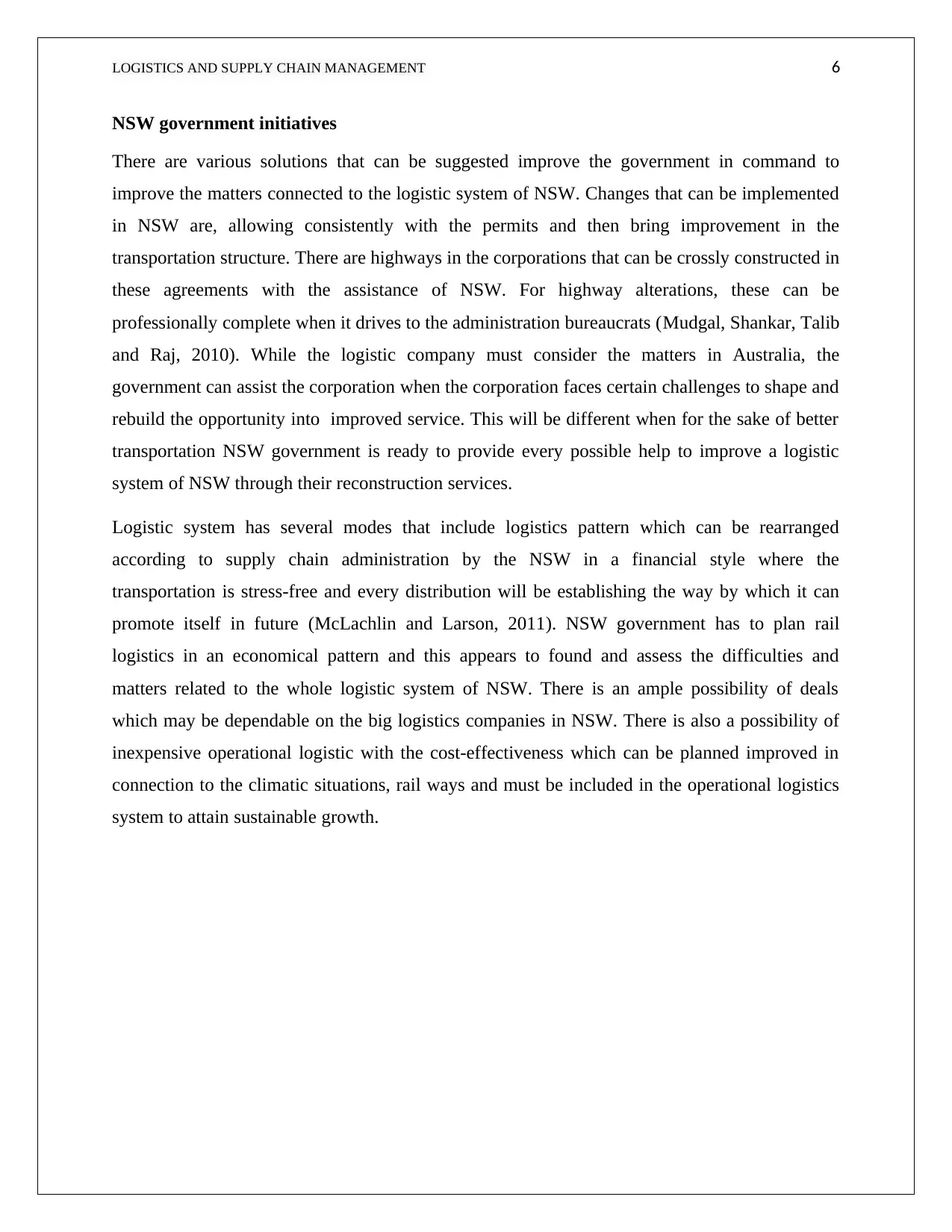
LOGISTICS AND SUPPLY CHAIN MANAGEMENT 6
NSW government initiatives
There are various solutions that can be suggested improve the government in command to
improve the matters connected to the logistic system of NSW. Changes that can be implemented
in NSW are, allowing consistently with the permits and then bring improvement in the
transportation structure. There are highways in the corporations that can be crossly constructed in
these agreements with the assistance of NSW. For highway alterations, these can be
professionally complete when it drives to the administration bureaucrats (Mudgal, Shankar, Talib
and Raj, 2010). While the logistic company must consider the matters in Australia, the
government can assist the corporation when the corporation faces certain challenges to shape and
rebuild the opportunity into improved service. This will be different when for the sake of better
transportation NSW government is ready to provide every possible help to improve a logistic
system of NSW through their reconstruction services.
Logistic system has several modes that include logistics pattern which can be rearranged
according to supply chain administration by the NSW in a financial style where the
transportation is stress-free and every distribution will be establishing the way by which it can
promote itself in future (McLachlin and Larson, 2011). NSW government has to plan rail
logistics in an economical pattern and this appears to found and assess the difficulties and
matters related to the whole logistic system of NSW. There is an ample possibility of deals
which may be dependable on the big logistics companies in NSW. There is also a possibility of
inexpensive operational logistic with the cost-effectiveness which can be planned improved in
connection to the climatic situations, rail ways and must be included in the operational logistics
system to attain sustainable growth.
NSW government initiatives
There are various solutions that can be suggested improve the government in command to
improve the matters connected to the logistic system of NSW. Changes that can be implemented
in NSW are, allowing consistently with the permits and then bring improvement in the
transportation structure. There are highways in the corporations that can be crossly constructed in
these agreements with the assistance of NSW. For highway alterations, these can be
professionally complete when it drives to the administration bureaucrats (Mudgal, Shankar, Talib
and Raj, 2010). While the logistic company must consider the matters in Australia, the
government can assist the corporation when the corporation faces certain challenges to shape and
rebuild the opportunity into improved service. This will be different when for the sake of better
transportation NSW government is ready to provide every possible help to improve a logistic
system of NSW through their reconstruction services.
Logistic system has several modes that include logistics pattern which can be rearranged
according to supply chain administration by the NSW in a financial style where the
transportation is stress-free and every distribution will be establishing the way by which it can
promote itself in future (McLachlin and Larson, 2011). NSW government has to plan rail
logistics in an economical pattern and this appears to found and assess the difficulties and
matters related to the whole logistic system of NSW. There is an ample possibility of deals
which may be dependable on the big logistics companies in NSW. There is also a possibility of
inexpensive operational logistic with the cost-effectiveness which can be planned improved in
connection to the climatic situations, rail ways and must be included in the operational logistics
system to attain sustainable growth.
Paraphrase This Document
Need a fresh take? Get an instant paraphrase of this document with our AI Paraphraser

LOGISTICS AND SUPPLY CHAIN MANAGEMENT 7
Conclusion
There are certain encounters that are confronted in Australia though BIS industry logistic system
has a main challenge and problem which are essential to be explored and inspected with the aid
of logistics philosophies of contingencies. The supply chain management seems to be better
suggestions in both forms, native as well as an international pattern. Method of logistics can be
likewise challenging and can be passed with the resolutions along with their suitable
applications. Though there are various types of challenges which are associated with a logistic
system like uncertain environment situations, bad conditions of roads and ongoing construction
projects in NSW. In addition, new rule and regulation related to transportation system have also
impacted the delivery time and time restriction related to logistic vehicles. There are specific
challenges that are being disregarded while using some approaches which are applied by BIS
industries to resolve challenges associated with NSW government. NSW government will play
one of the most important roles in raising fund related to the railway logistic system
improvement in NSW.
Conclusion
There are certain encounters that are confronted in Australia though BIS industry logistic system
has a main challenge and problem which are essential to be explored and inspected with the aid
of logistics philosophies of contingencies. The supply chain management seems to be better
suggestions in both forms, native as well as an international pattern. Method of logistics can be
likewise challenging and can be passed with the resolutions along with their suitable
applications. Though there are various types of challenges which are associated with a logistic
system like uncertain environment situations, bad conditions of roads and ongoing construction
projects in NSW. In addition, new rule and regulation related to transportation system have also
impacted the delivery time and time restriction related to logistic vehicles. There are specific
challenges that are being disregarded while using some approaches which are applied by BIS
industries to resolve challenges associated with NSW government. NSW government will play
one of the most important roles in raising fund related to the railway logistic system
improvement in NSW.
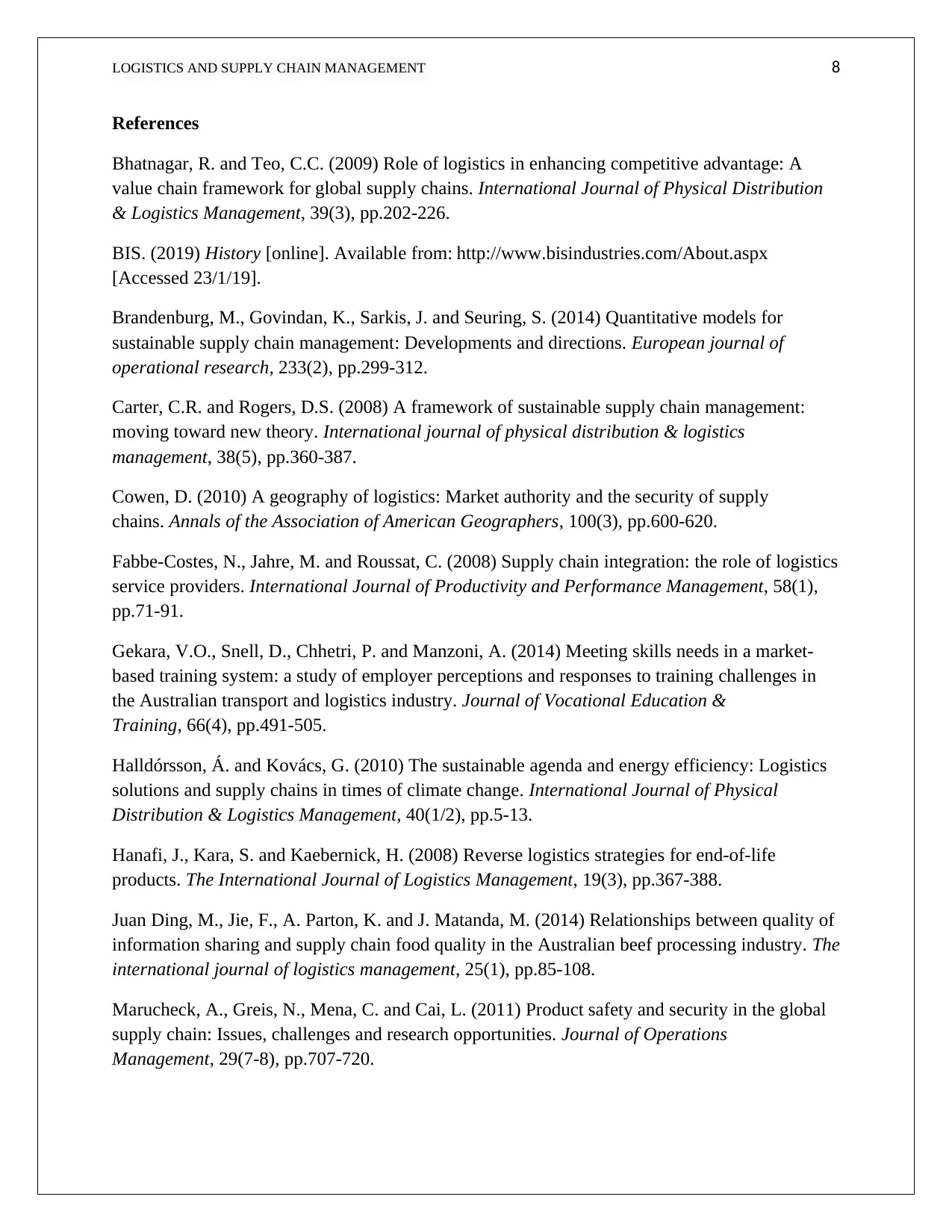
LOGISTICS AND SUPPLY CHAIN MANAGEMENT 8
References
Bhatnagar, R. and Teo, C.C. (2009) Role of logistics in enhancing competitive advantage: A
value chain framework for global supply chains. International Journal of Physical Distribution
& Logistics Management, 39(3), pp.202-226.
BIS. (2019) History [online]. Available from: http://www.bisindustries.com/About.aspx
[Accessed 23/1/19].
Brandenburg, M., Govindan, K., Sarkis, J. and Seuring, S. (2014) Quantitative models for
sustainable supply chain management: Developments and directions. European journal of
operational research, 233(2), pp.299-312.
Carter, C.R. and Rogers, D.S. (2008) A framework of sustainable supply chain management:
moving toward new theory. International journal of physical distribution & logistics
management, 38(5), pp.360-387.
Cowen, D. (2010) A geography of logistics: Market authority and the security of supply
chains. Annals of the Association of American Geographers, 100(3), pp.600-620.
Fabbe-Costes, N., Jahre, M. and Roussat, C. (2008) Supply chain integration: the role of logistics
service providers. International Journal of Productivity and Performance Management, 58(1),
pp.71-91.
Gekara, V.O., Snell, D., Chhetri, P. and Manzoni, A. (2014) Meeting skills needs in a market-
based training system: a study of employer perceptions and responses to training challenges in
the Australian transport and logistics industry. Journal of Vocational Education &
Training, 66(4), pp.491-505.
Halldórsson, Á. and Kovács, G. (2010) The sustainable agenda and energy efficiency: Logistics
solutions and supply chains in times of climate change. International Journal of Physical
Distribution & Logistics Management, 40(1/2), pp.5-13.
Hanafi, J., Kara, S. and Kaebernick, H. (2008) Reverse logistics strategies for end-of-life
products. The International Journal of Logistics Management, 19(3), pp.367-388.
Juan Ding, M., Jie, F., A. Parton, K. and J. Matanda, M. (2014) Relationships between quality of
information sharing and supply chain food quality in the Australian beef processing industry. The
international journal of logistics management, 25(1), pp.85-108.
Marucheck, A., Greis, N., Mena, C. and Cai, L. (2011) Product safety and security in the global
supply chain: Issues, challenges and research opportunities. Journal of Operations
Management, 29(7-8), pp.707-720.
References
Bhatnagar, R. and Teo, C.C. (2009) Role of logistics in enhancing competitive advantage: A
value chain framework for global supply chains. International Journal of Physical Distribution
& Logistics Management, 39(3), pp.202-226.
BIS. (2019) History [online]. Available from: http://www.bisindustries.com/About.aspx
[Accessed 23/1/19].
Brandenburg, M., Govindan, K., Sarkis, J. and Seuring, S. (2014) Quantitative models for
sustainable supply chain management: Developments and directions. European journal of
operational research, 233(2), pp.299-312.
Carter, C.R. and Rogers, D.S. (2008) A framework of sustainable supply chain management:
moving toward new theory. International journal of physical distribution & logistics
management, 38(5), pp.360-387.
Cowen, D. (2010) A geography of logistics: Market authority and the security of supply
chains. Annals of the Association of American Geographers, 100(3), pp.600-620.
Fabbe-Costes, N., Jahre, M. and Roussat, C. (2008) Supply chain integration: the role of logistics
service providers. International Journal of Productivity and Performance Management, 58(1),
pp.71-91.
Gekara, V.O., Snell, D., Chhetri, P. and Manzoni, A. (2014) Meeting skills needs in a market-
based training system: a study of employer perceptions and responses to training challenges in
the Australian transport and logistics industry. Journal of Vocational Education &
Training, 66(4), pp.491-505.
Halldórsson, Á. and Kovács, G. (2010) The sustainable agenda and energy efficiency: Logistics
solutions and supply chains in times of climate change. International Journal of Physical
Distribution & Logistics Management, 40(1/2), pp.5-13.
Hanafi, J., Kara, S. and Kaebernick, H. (2008) Reverse logistics strategies for end-of-life
products. The International Journal of Logistics Management, 19(3), pp.367-388.
Juan Ding, M., Jie, F., A. Parton, K. and J. Matanda, M. (2014) Relationships between quality of
information sharing and supply chain food quality in the Australian beef processing industry. The
international journal of logistics management, 25(1), pp.85-108.
Marucheck, A., Greis, N., Mena, C. and Cai, L. (2011) Product safety and security in the global
supply chain: Issues, challenges and research opportunities. Journal of Operations
Management, 29(7-8), pp.707-720.
⊘ This is a preview!⊘
Do you want full access?
Subscribe today to unlock all pages.

Trusted by 1+ million students worldwide

LOGISTICS AND SUPPLY CHAIN MANAGEMENT 9
McLachlin, R. and Larson, P.D. (2011) Building humanitarian supply chain relationships:
lessons from leading practitioners. Journal of Humanitarian Logistics and Supply Chain
Management, 1(1), pp.32-49.
Mudgal, R.K., Shankar, R., Talib, P. and Raj, T. (2010) Modelling the barriers of green supply
chain practices: an Indian perspective. International Journal of Logistics Systems and
Management, 7(1), pp.81-107.
Niculescu, M.C. and Minea, M. (2016) Developing a single window integrated platform for
multimodal transport management and logistics. Transportation Research Procedia, 14,
pp.1453-1462.
Prajogo, D. and Olhager, J. (2012) Supply chain integration and performance: The effects of
long-term relationships, information technology and sharing, and logistics
integration. International Journal of Production Economics, 135(1), pp.514-522.
Prajogo, D. and Sohal, A. (2013) Supply chain professionals: a study of competencies, use of
technologies, and future challenges. International Journal of Operations & Production
Management, 33(11/12), pp.1532-1554.
Rodrigue, J.P. and Notteboom, T. (2009) The terminalization of supply chains: reassessing the
role of terminals in port/hinterland logistical relationships. Maritime Policy &
Management, 36(2), pp.165-183.
Seuring, S. and Müller, M. (2008) From a literature review to a conceptual framework for
sustainable supply chain management. Journal of cleaner production, 16(15), pp.1699-1710.
Sohal, A.S. (2013) Developing competencies of supply chain professionals in Australia:
collaboration between businesses, universities and industry associations. Supply Chain
Management: An International Journal, 18(4), pp.429-439.
Varsei, M. and Polyakovskiy, S. (2017) Sustainable supply chain network design: A case of the
wine industry in Australia. Omega, 66, pp.236-247.
McLachlin, R. and Larson, P.D. (2011) Building humanitarian supply chain relationships:
lessons from leading practitioners. Journal of Humanitarian Logistics and Supply Chain
Management, 1(1), pp.32-49.
Mudgal, R.K., Shankar, R., Talib, P. and Raj, T. (2010) Modelling the barriers of green supply
chain practices: an Indian perspective. International Journal of Logistics Systems and
Management, 7(1), pp.81-107.
Niculescu, M.C. and Minea, M. (2016) Developing a single window integrated platform for
multimodal transport management and logistics. Transportation Research Procedia, 14,
pp.1453-1462.
Prajogo, D. and Olhager, J. (2012) Supply chain integration and performance: The effects of
long-term relationships, information technology and sharing, and logistics
integration. International Journal of Production Economics, 135(1), pp.514-522.
Prajogo, D. and Sohal, A. (2013) Supply chain professionals: a study of competencies, use of
technologies, and future challenges. International Journal of Operations & Production
Management, 33(11/12), pp.1532-1554.
Rodrigue, J.P. and Notteboom, T. (2009) The terminalization of supply chains: reassessing the
role of terminals in port/hinterland logistical relationships. Maritime Policy &
Management, 36(2), pp.165-183.
Seuring, S. and Müller, M. (2008) From a literature review to a conceptual framework for
sustainable supply chain management. Journal of cleaner production, 16(15), pp.1699-1710.
Sohal, A.S. (2013) Developing competencies of supply chain professionals in Australia:
collaboration between businesses, universities and industry associations. Supply Chain
Management: An International Journal, 18(4), pp.429-439.
Varsei, M. and Polyakovskiy, S. (2017) Sustainable supply chain network design: A case of the
wine industry in Australia. Omega, 66, pp.236-247.
1 out of 10
Related Documents
Your All-in-One AI-Powered Toolkit for Academic Success.
+13062052269
info@desklib.com
Available 24*7 on WhatsApp / Email
![[object Object]](/_next/static/media/star-bottom.7253800d.svg)
Unlock your academic potential
Copyright © 2020–2025 A2Z Services. All Rights Reserved. Developed and managed by ZUCOL.





